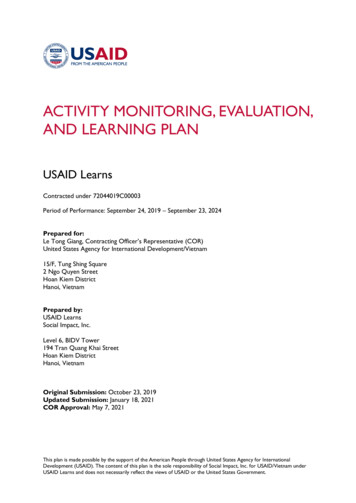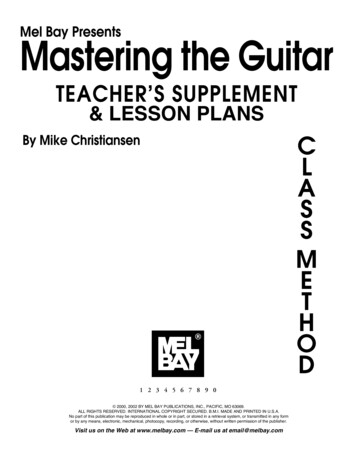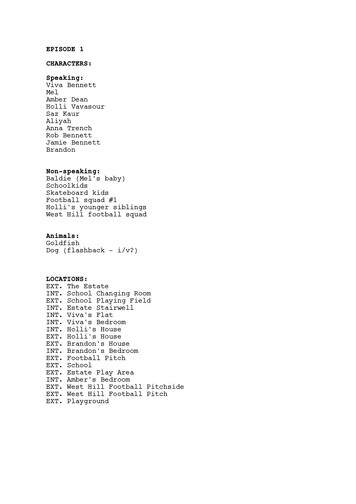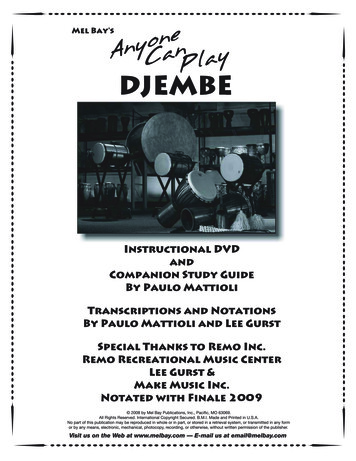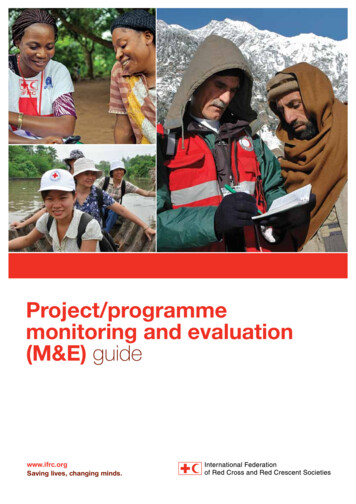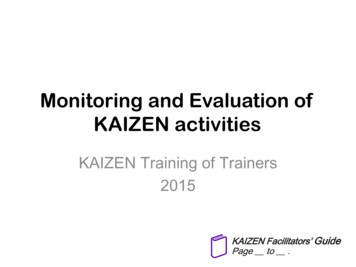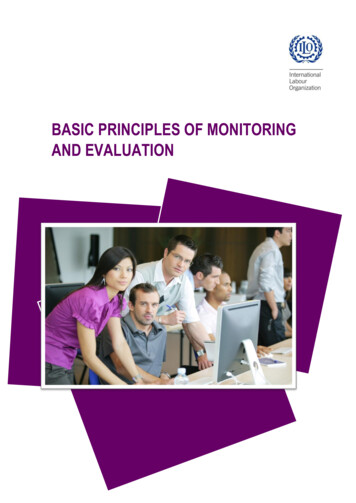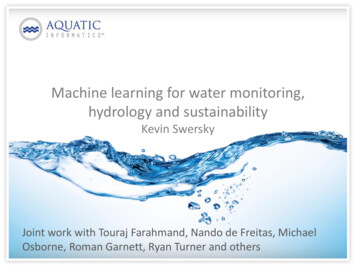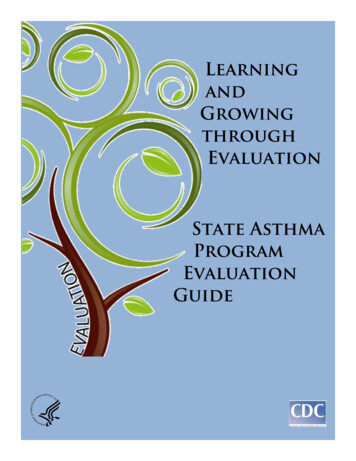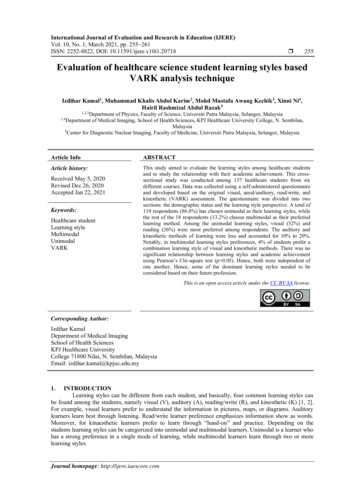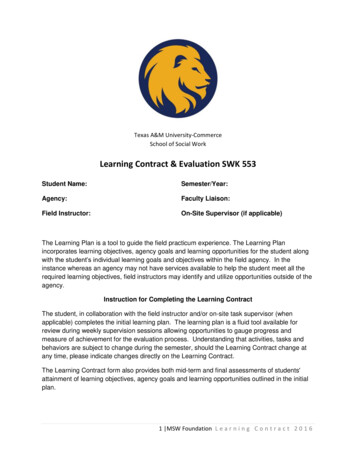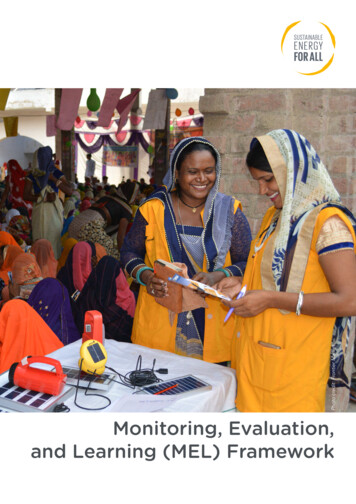
Transcription
Photo credit: Frontier MarketMonitoring, Evaluation,and Learning (MEL) Framework
CONTENTSSUSTAINABLE ENERGY FOR ALL MONITORING, EVALUATION, AND LEARNING FRAMEWORK. 03CONTEXT. 03SEforALL’S PROGRAM THEORY. 05ACHIEVING OUTCOMES: LEADERS WHO UNLOCK FINANCE AND BROKER PARTNERSHIPS. 06INTERMEDIATE OUTCOMES: INSIGHT, MOTIVATION, DECISIONS TOWARDS FINANCE AND PARTNERSHIPS.07SEforALL INTERVENTIONS. 07ACTIVITIES: SEforALL’S THEORY OF ACTION. 08THE GENDER DIMENSION IN SEforALL’S PROGRAM THEORY. 08ENABLING ENVIRONMENT. 09ASSUMPTIONS. 09APPROACHES FOR MONITORING, EVALUATION, AND LEARNING (MEL) . 10GENERAL PRINCIPLES FOR MONITORING. 10A FRAMEWORK FOR THE SEforALL ORGANIZATION. 11IMPLEMENTING MONITORING, EVALUATION, AND LEARNING (MEL) . 12MONITORING AND LEARNING SCOPE AND ACTIVITIES. 12EVALUATION AND LEARNING SCOPE AND ACTIVITIES. 13REPORTS AND REPORTING CYCLES . 14MONITORING REPORTS. 14EVALUATION AND EVALUATION REPORTS. 15LEARNING AND LEARNING REPORTS. 15REVIEWING AND ADJUSTING THE MONITORING, EVALUATION, AND LEARNING (MEL) FRAMEWORK. 17ANNEX 1: OECD DAC CRITERIA FOR EVALUATION. 18ANNEX 2A: THEORY OF ACTION - ACTIVITY PORTFOLIO. 20ANNEX 2B: ACTIVITY-TO-INTERVENTION MATRIX (EXAMPLES). 21ANNEX 3: ACTIVITY MONITORING INDICATORS. 23ANNEX 4: OUTPUT INDICATORS. 24ANNEX 4A: INTERMEDIATE OUTCOME INDICATORS ACCESSED THROUGH EVALUATION. 27ANNEX 4B: OUTPUT INDICATORS ASSESSED THROUGH EVALUATION. 29ANNEX 5: MONITORING EFFICIENCIES AT THE ORGANIZATIONAL LEVEL (EXAMPLES). 30ANNEX 6: THE MONITORING PROCESS AT SEforALL. 3102
SEforALL MONITORING, EVALUATION & LEARNING FRAMEWORKSUSTAINABLE ENERGY FOR ALLMONITORING, EVALUATION, AND LEARNINGFRAMEWORKCONTEXTThis Monitoring, Evaluation, and Learning (MEL)Framework lays out how the SEforALL organization monitors its resources, its activities, and its results; how periodic assessments and analyses will guide and accompanyimplementation; and how the information generated frommonitoring and evaluation will be reflected upon andused to improve SEforALL’s performance.The SEforALL organization’s mission is to help leadersmobilize the investments and broker the partnershipsThe SEforALL Organization: The SEforALL organization (also “Global Team”) is an internationalNon-Governmental Organization, incorporated inAustria under the legal format of “Quasi-International Organizations.” The Global Team supports amulti-stakeholder platform—the “movement”—focused on the delivery of Sustainable DevelopmentGoal #7: Sustainable Energy for All. Leveraging anetwork of high-value partnerships, SEforALL drawson and engages governments, business, and civilsociety. SEforALL has strong ties with the UN, formalized through a relationship agreement.necessary for implementing actions towards sustainableenergy for all with the understanding that both—investments and partnerships—are essential for such actions tobe successful (and to “go further faster”). The SEforALLorganization—as part of and in support of the SEforALLsustainable energy for all movement—pursues its overarching goal to substantively contribute, by 2030, to advancing progress on three main objectives: (a) ensuringuniversal access to modern energy services; (b) doublingthe share of renewable energy in the global energy mix;and (c) doubling the global rate of improvement in energy efficiency. A key element of the underlying rationaleis that ”frontloading” efforts to meet the energy accessgoal will be necessary and possible through progress onenergy efficiency and renewables. Importantly, both willhelp create an energy system that takes up less planetaryspace and keeps emissions to levels that allow fulfillmentof the Paris Agreement. This MEL framework should thusbe understood in the context of—but not as part of—themonitoring arrangements associated with the SustainableDevelopment Goals (SDGs).1 As part of the 2030 agenda,and as agreed by the General Assembly, the indicatorsand monitoring for SDGs is a separate process. Reportingon SDG 7 will take place, for the first time, at the 2018HLPF, with data provided by, among others, the SEforALLKnowledge Hub, and made accessible by the SEforALLGlobal Team.Ensuring access to affordable, reliable, sustainable, p?page view&type 400&nr 2013&menu 3503
modern energy is part of the broader suite of commitments made by the UN’s 193 member states towards 17Sustainable Development Goals (SDGs) by 2030. Progresstowards the energy goal—SDG 7—will be needed toachieve many of the other goals. As a global community,the world needs to move faster to meet this challenge.Many countries are taking action, but more rapid progressis necessary. The April 2017 Global Tracking Framework2of Sustainable Energy for All reports that global electrification had reached 85.3 percent in 2014—a modest improvement since 2012, still leaving some 1.06 billion peoplewith no access to electricity. At the same time, only 57.4percent of the world’s population were found to have access to clean cooking, just a slight increase over 2012. Indeed, the total number of people without access to cleancooking had risen from 2.9 billion to 3.04 billion, indicating that efforts to advance access are not keeping up withpopulation growth. Despite progress made in technologyand falling prices in the electricity sector, particularly forsolar and wind, the gains in renewables in the energy mixhad been a fraction of what is needed to meet global ob-2jectives. By 2014, the share of renewable energy in totalenergy consumption had climbed to 18.3 percent, a slightacceleration since 2010 but nowhere near fast enough todouble its share to the 36 percent aimed at for the 201030 period. Countries that have set aggressive targets forrenewable energy are seeing rapid progress; they nowneed to be joined by others. Progress in energy efficiencyhas gained momentum, in industry, agriculture, services,and transport. The energy intensity of the global economyimproved, between 2012 and 2014, by a 2.1 percent compound average annual growth rate, still falling short of butgetting closer to the SEforALL objective of –2.6 percent.Yet, improvements in the efficiency of thermal power generation and power networks had been relatively slow andthe fast-growing residential sector had become more—rather than less—energy intensive. Investment in energyefficiency, the report finds, needs to increase by a factorof three to six from the current 250 billion a year to reachthe 2030 objective. Across all three SEforALL objectives,financial flows are currently at only about one-third of the 1.0-1.2 trillion per year /GTF%20Executive%20Summary%202017 0.pdf04
SEforALL MONITORING, EVALUATION & LEARNING FRAMEWORKSEforALL’S PROGRAM THEORY3Evaluated byexternal partyTracked byGlobal TrackingFrameworkFIGURE 1: DIAGRAM ILLUSTRATING THE SEforALL GLOBAL TEAM’S PROGRAM THEORY4ImpactOutcomeMonitired for SEforALLInterOutcomemediateOutcomeImprovementRate in EnergyEfficiency:Doubled GloballyUniversal Accessto Modern EnergyServices: EnsuredLeaders unlock Finance forSustainable Energy for AllRenewable EnergyShare in the GlobalMix: DoubledLeaders brocker Partnershipsfor Sustainable Energy for AllLeaders aremotivatedto act uponstrategic insights,communicationsand partnershipopportunitiesLeaders accessnew strategicinsights,communicationand partnershipsLeaders have theopportunity tomake decisionsto unlockfinance or brokerpartnershipsOther InfluencesFactors in theenabling environmentinclude: Dem and formodern energyincreases; Internationalenablingenvironmentincludes incentivesetc.SEforALL Global Team INTERVENTIONSOutputCombining Stategic Insights, Communication and PartnershipsEnergyEfficiency FirstActivitiesStories ofsuccessNo One LeftBehindResearch &ReportsCoalitions tor EngagementCross-cuttingInputThe enabling environmentKnowledgeSharingOpeningDoorsFull list of Activities to be found in the Theory of ing loopsSystems &Processes**Examples for Inputs for the effective operations ofSEforALLAssumptions (examples) Energy providersare able to deliveradequate, cost-effectiveservices There is political willto act Barriers for access toenergy services areaddressedNote to the Diagram: The Theory of Action is embedded at the Activity Level. (See Annex 2 for more detail.)A program theory explains how an intervention (a project, a program, a policy, a strategy) is understood to contribute to a chain of resultsthat produce the intended or actual impacts. It can also show the other factors that contribute to producing impacts, such as context andother projects and programs. Different types of diagrams can be used to represent a program theory. These are sometimes referred to aslogic models, as they show the overall logic of how the intervention is understood to work. A program theory typically includes a situationanalysis/description of the context; identifying outcomes; broadly describing how change is to come about; action theories—what will bedone to activate each of the changes sought; a discussion of sustainability and scale; and, possibly, unintended impacts. A Business Model isthe specific arrangement undertaken, at the organizational level, to facilitate the organization’s goals (including value proposition, architecture, finance, etc.).34The Illustration was developed through consultation and may be subject to revisions and change regarding assumptions and external factors.05
ACHIEVING OUTCOMES: LEADERSWHO UNLOCK FINANCE AND BROKERPARTNERSHIPSand their difficulties in identifying the right partners to workwith, be these partners for financing projects or partners formoving forward ideas and reforms.To meet the 2030 goals in the context of the Paris Agreement presents a formidable challenge. Rising to thischallenge will require leadership of all kinds—and it willneed to come from leaders at many levels and includetracking with a monitoring tool to ensure that we are usingthe same or equal categories, whether elected leaders innational and local governments, multilateral organizations,CEOs of companies, financiers, development banks, research organizations, labor unions, and communities andcivil society. Each country will determine its pathway depending on where it finds itself in its development journeynow. Each company, city, and community will also determine its way forward similarly. This means different interventions and supports for different leaders.Outcomes pursued: The SEforALL Global Team’s response: The SEforALL Global Team’s mission is to help leaders mobilize the investment and broker the partnershipsnecessary for implementing actions towards sustainableenergy for all with the understanding that both, investmentand partnerships, are essential for such actions to be successful (and to “go further faster”). Thus, the outcomes pursued by the SEforALL Global Team and its partnerscan bedescribed as:What do leaders need? The urgency of the need to moveforward with the energy transition is understood differently.The availability of technology, finance, institutional capacity,and political will differs. The evidence base accumulated bySEforALL and its partners—and across other reliable datasets, including the Global Tracking Framework, RISE indicators, Bloomberg New Energy Finance surveys, the Energy Transition Commission’s report, the IEA World EnergyOutlook, as well as commissioned work on financial flows—shows that we are not on track to meet our goals. Whilethere is much to excite optimism that we can achieve them,we are not yet at speed and scale in managing the energytransition. Leaders in government, business, and civil society working in the energy sector and on its transformationhave asked the SEforALL Global Team5 for help in understanding and interpreting the large amounts of data available on where they and their organizations find themselveswithin the global context of moving towards sustainableenergy for all. They have also pointed to the challengesthey face in focusing themselves and their organizations, Leaders are unlocking finance for action from multiplesources, including public and private, bilateral and multilateral, traditional and non-traditional sources. Here,the contribution of the SEforALL Global Team and itspartners is to help leaders unlock finance—from investors interested in options at the country level—for centralized and decentralized energy solutions for energyefficiency and for renewable energy. SEforALL does thisby fostering partnerships and knowledge sharing totake actions that address barriers to financial flows. Leaders are brokering partnerships and conversations across the public and private sectors and civil society to jumpstart progress. Here, the contribution ofthe SEforALL Global Team and its partners is to helpleaders identify and connect with partners that (a) cansupport the creation of the enabling environments orthe innovative approaches and business models thatthey can quickly scale and replicate and/or (b) supporta common direction across country-level initiatives andlink the energy and climate change agendas. Beyonddirectly fostering such partnerships, SEforALL alsoshines a light on partnerships that exist and challengesthem to stay on track.Between January and May of 2016, SEforALL extensively consulted with leaders in the energy and development sectors on what leadersneed to move from insight to action and on what an organization such as SEforALL can offer these leaders to help them take critical stepstowards implementation.506
SEforALL MONITORING, EVALUATION & LEARNING FRAMEWORKINTERMEDIATE OUTCOMES: INSIGHT,MOTIVATION, DECISIONS TOWARDSFINANCE AND PARTNERSHIPSThere are several ways to support leaders in successfully transforming energy systems.6 In working with leaders,SEforALL focuses specifically on the strategic insight7 andthe motivation8 leaders need to make decisions.9 Alignedwith research on data-driven decision-making, SEforALL’sinterventions combine strategic insight with communications and partnerships to help leaders build a sense ofhow the data and information presented are relevant tothem and their constituencies by assisting with arguments,evidence, data, and stories to encourage action.10 This action-oriented perspective then shapes how, together withits partners, SEforALL connects leaders to the knowledgeof what is needed and when, what is working well and why.To further enhance motivation, SEforALL also sheds light onthe progress being made by the international communityand brings attention to areas where strengthened engagement and action are needed to ensure we stay on courseto meet the 2030 objectives. In summary, SEforALL understands that intermediate outcomes are achieved throughleadership engagement that helps leaders gain accessto strategic insights, build and maintain motivation, andarrive at opportunities to make decisions that implementpathways relevant to brokering partnerships and unlockingfinance in support of sustainable energy for all.SEforALL INTERVENTIONSSEforALL’s interventions11 are based on the rationale thatleaders need, seek, and will benefit from strategic engagements designed to help them focus and stay on course.SEforALL’s interventions systematically draw on strategic insight, build on compelling communications, and are delivered through and include action-oriented partnerships: Strategic Insight: Interventions are shaped strategically,based on where there is potential for high impact, onwhat is needed, and on what new perspectives we canoffer leaders on how to achieve impact. Action-Oriented Partnerships: SEforALL supports action through “delivery partners” that drive leadershipengagements, offer insight, and mobilize collaborativecommitments; SEforALL also brings new players to thetable and—through the “proud partners” engagementformat—the many groups, organizations, businesses,and others that subscribe to our common objectives andwho will be part of specific activities or interventions. Compelling Communications: SEforALL helps goodnews travel faster, using all media channels to packagedata, information, and evidence. We tell success storiesand let leaders know what is working, where, when, andwhy. This includes shaping messages that reflect the promise and challenges faced in achieving our objectives bymaking stories and data visually accessible, thus allowingmore diverse decision-makers to act and spur results.SEforALL’s actions are based on the assumption that an individual’s motivation, opportunity, and ability to act drive shifts in behavior [fromThe Behavior Change Wheel (Michie, Atkins, & West. (2014). The behavior change wheel: A guide to designing interventions. SilverbackPublishing.)].67Strategic insights are defined as the habits, tasks, and knowledge required to catalyze or enhance action towards sustainable energy for all.8Motivation is defined as the impetus for action on a series of goal-oriented behaviors that work towards sustainable energy for all.Opportunities to make decisions are defined as the situational conditions that allow leaders to form new partnerships that unlock financingfor and drive action towards sustainable energy for all.9Steps needed to move from data to information and from there to knowledge and actionable insight have first been described by systemsthinking pioneer Russell Ackoff [R. L., «From Data to Wisdom,» Journal of Applied Systems Analysis, Volume 16, 1989 p 3-9] and later refinedacross the organizational change, systems thinking, and knowledge management literature.1011SEforALL Interventions are all built around and draw on evidence and strategic insight, communications, and partnerships.07
SEforALL’s interventions will be different depending onthe geography and the strategic outcome intended. Forexample, an SEforALL Global Team intervention wouldbe to leverage data from the Global Tracking Framework(GTF) and the Regulatory Indicators for Sustainable Energy (RISE) reports, among others, by visually “packaging”the data for easy consumption, translating it into information that provides strategic insights for specific leaders. Supported by targeted communications outreach,this data then informs leadership conversations. Throughcommunications and partnership creation, these insightscan then translate into motivation by creating opportunities for making decisions.Beyond directly conveying strategic insight to leaders, theSEforALL Global Team will also invest in providing robustdata and analysis, combined with the right communication efforts, to make a case for sustainable energy strongenough to inform decisions in the context of national priorities to SEforALL’s platform – partners such as RegionalHubs or Accelerators. Helping leaders build motivationto deliver results will also involve developing a globalmovement for action. On the industry level, for example,SEforALL works with its Accelerators—industry partners,government, and civil society organizations—to accelerate action, coordinate, and share knowledge aroundareas of common interest. Similarly, at the country level,SEforALL works with partners that are assisting countriesto craft operable Action Agendas and Investment Prospectuses to ensure they put forward strong energy proposals and integrate tools to track performance. Here,individual engagements and dialogue at the leadershiplevel create the opportunities that will empower leadersto make decisions that can accelerate action towards mobilized financing and brokered partnerships.ACTIVITIES: SEforALL’S THEORY OFACTIONAll interventions, as described above, are comprised of individual activities. To complement its Program Theory andfacilitate monitoring, Sustainable Energy for ALL has puttogether a Theory of Action describing the activities thatare part of the result chain. Activities include actions takenor work performed by the Policy & Knowledge team, theCommunications team, and the Partnerships team. Byusing its financial resources, people, systems, and processes, SEforALL develops activities such as workshops,reports, individual engagements, and communicationstrategies, among others. These activities—aligned withSEforALL’s value proposition—then jointly form individualinterventions. Annex 2 describes: (a) the main activities undertaken by SEforALL’s team and (b) examples for activitymonitoring indicators. Indicators will follow the interventions laid out in the SEforALL work plan, initially set specifically for each individual intervention on a case-by-casebasis and not standardized across interventions. As examples of this, for the Intervention “Launch of the GlobalTracking Framework,” the indicator to be monitored maybe the counterpart’s satisfaction with the strategic insightprovided by the SEforALL Global Team, as well as thecommunications plan and the social media outreach; andfor the intervention “Forum 2017,” the indicators to bemonitored may also include participant survey responsesindicating that participants have been able to make new/promising connections following that intervention.THE GENDER DIMENSION IN SEforALL’SPROGRAM THEORYIn going further, faster, together towards the 2030 objectives of SDG 7, SEforALL recognizes the need for a sociallyinclusive and gender-responsive energy transition.12 Thisemphasis is thus reflected in the Program Theory as wellas in the Theory of Action and, consequently, in theSee also page 50 in the SEforALL Strategic Framework for Results where the various dimensions of social inclusion and gender perspectivesof the energy transition are discussed.1208
SEforALL MONITORING, EVALUATION & LEARNING FRAMEWORKSEforALL work streams. Indicators deployed for monitoring SEforALL interventions reflect appropriate genderdimensions.In addition to the monitoring of SEforALL’s own interventions, SEforALL has set up the “People-Centered Accelerator” as a voluntary partnership of stakeholders interested in advancing gender equality, social inclusion, andwomen’s empowerment in the sustainable energy sector.Partners associated with this work will pay particular attention and reflect critical gender dimensions in their workwith SEforALL (e.g., low income women and girls are accessing sustainable energy). SEforALL is also exploringwith its private sector partners how they can mainstreamgender considerations in their SEforALL-related projectsand report this appropriately.ENABLING ENVIRONMENTSEforALL as an organization is not able to directly influence the enabling environment under which the leadersit works with operate, though there will likely be indirectinfluence, even if hard to attribute. Specifically, the political, economic, and technological context that is drivingthe demand for modern energy is beyond SEforALL’s intervention space. As far as indirect influence is possible,it will be taken up. For example, SEforALL’s work with leaders in the energy sector can—through strategic insight,communications, and partnership mobilization—help toindirectly shape the global demand for modern energy ifthese leaders are followed and copied by others. Similarly, convening of finance leaders could persuade governments to enact specific regulations. Attribution of suchindirect influence is unlikely to be possible; however, later-stage evaluations of the full program can indicate therelevance of an intervention and its interactions with, andcontributions to, the enabling environment.ASSUMPTIONSThere are a number of assumptions that underpin the Program Theory and how our inputs are expected to translateinto outputs that would then lead to the achievement ofoutcomes. Some of these can be managed or influencedand some are outside of the control of the SEforALL Global Team and its partners. For example, it is assumed thatboth the international and national political and economic contexts within which leaders operate is conduciveto the changes required to achieve the outcomes. Othercritical assumptions include, among others, that the removal of barriers to access to energy services is possiblefor the target beneficiaries and that energy providers candeliver adequate, cost-effective services. Finally, it is assumed that forming alliances, networks, and partnershipsbetween public and private sector leaders—as well as access to financing—can be the driving forces needed forchange. These assumptions and others identified will befurther examined through the monitoring and evaluationactivities.SEforALL’s broader program theory does not touch uponthe investments or partnerships themselves that resultfrom its activities or on the implementation of decisionstaken towards sustainable energy for all. It assumes thatonce leaders unlock finance and broker partnerships,these investments in and partnerships towards sustainable energy for all take place effectively and efficientlyand that, over time, they result in progress towards improving the rate in energy efficiency, growing the share ofrenewable energy in the global energy mix, and providinguniversal access to modern energy services. The ProgramTheory also assumes that the actions taken by leaders aresuccessful and relevant and can incentivize replication.These are testable assumptions that are, however, beyondthe scope of this MEL framework but could be exploredthrough further research or evaluation.09
APPROACHES FOR MONITORING,EVALUATION, AND LEARNING(MEL)SEforALL’s MEL framework is based on its Program Theory and its Theory of Action. The former specifies the intermediate and long-term outcomes that need to beachieved to substantially contribute towards its 2030 objectives.13 The latter specifies individual and monitorableactivities that contribute to interventions ( outputs) delivered by SEforALL. The purpose of the two frameworkstogether is to ensure accountability and learning througha means of tracking, where possible, the delivery of interventions (outputs) and their intermediate outcomes. Theinformation produced will inform decisions and ensure thatSEforALL’s interventions are and remain relevant, and aredirected efficiently and effectively towards successful outcomes and, ultimately, the achievement of its overall goals.GENERAL PRINCIPLES FOR MONITORINGMonitoring will be commensurate with SEforALL’s size andbusiness model and it will be focused on specific interventions (outputs). Monitoring will cover levels 2, 3 and 4outlined in the SEforALL strategic framework (see below).Monitoring of high-level impacts (level 1)—by tracking progress in universal energy access, energy efficiency, and renewable energy—takes place through the Global TrackingFramework and goes beyond monitoring done with regardto the Program Theory and the Theory of Acton underpinning SEforALL’s interventions and the progress madetowards their outcomes.Level 1: High-level impact (universal access, energy efficiency, renewable energy): monitored through the GlobalTracking Framework and not within this MEL Framework.Level 2: Intermediate outcomes (SEforALL interventionlevel): leaders unlock finance and broker partnerships;SEforALL monitors by assessing relevant intermediateoutcomes.Level 3: Interventions ( Outputs) and Activities (SEforALLintervention level): SEforALL monitors intervention-specific indicators for delivery, along th
05 SEforALL MONITORING, EVALUATION LEARNING FRAMEWORK SEforALL’S PROGRAM THEORY3 3 A program theory explains how an intervention (a project, a program, a policy, a strategy) is understood to contribute to a chain of results that produce the intended or actual impacts. It can also show the othe
